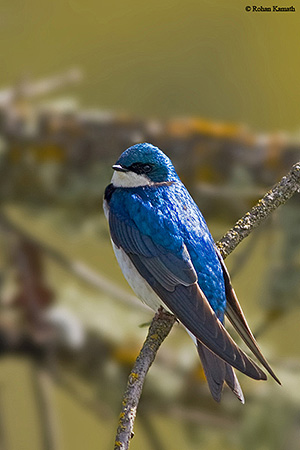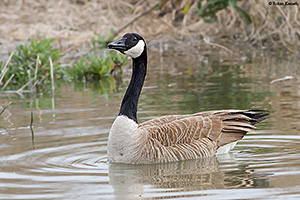Monogamy |
|
|---|---|

  photograph of House Wren (top) by Tom Grey Tree Swallow (middle) and Canada Goose (bottom) by Tom Grey |
An
estimated 90 percent of all bird species are monogamous.
Monogamy is defined as one male mating with one female and
forming a "pair bond." That bond may last for a single
nesting (House Wrens), an entire breeding season (most bird
species, including most passerines), several successive
breeding seasons (observed in some pairs of American Robins,
Tree Swallows, Mourning Doves, etc.), or life (albatrosses,
petrels, swans, geese, eagles, and some owls and
parrots). Presumably monogamy evolved in situations where young have a much better chance of surviving if both parents cooperate in rearing them. Nonetheless, the amount of time and energy invested by monogamous male parents varies greatly. The Willow Ptarmigan male serves only as a sentinel watching for danger. The Eastern Bluebird male provides a site for the rearing of young (by defending a territory containing a nest cavity), but experimental removal of males has shown that they are not essential for successful brood-rearing. In some monogamous species, the male defends a territory in which his mate collects the food required by the offspring, but does not himself feed the nestlings. Levels of male parental investment are even higher in most passerines, where males feed brooding females and/or help to feed the young. In herons, egrets, some woodpeckers, and others, males not only provide food for the young but share in incubation as well. The ante is raised even further in such ground-nesting birds as geese, swans, gulls, terns, and shorebirds in which males also commonly place themselves in danger by vigorously defending the nest and young from predators. The traditional view of why more or less permanent monogamous bonds are formed is changing, as interest has become focused on the parentage of offspring reared by "monogamous" pairs. Increasingly, ornithologists and behavioral ecologists have come to view monogamy as part of a "mixed" reproductive strategy in which matings may occur outside the primary pair bond, but both members of the pair still contribute substantially only to the care and feeding of the young from their own nest. Some species are viewed as facultatively monogamous; that is, if released from certain environmental constraints, they would typically exhibit some other form of mating system such as polygyny (one male mating with more than one female) or promiscuity (mating without forming pair bonds). According to this view, for example, North American dabbling ducks are monogamous only because males are unable to monopolize more than one female. These ducks breed synchronously and their populations typically contain more males than females. Two lines of evidence have contributed to the shift in viewpoint about the nature of monogamy. First, ecologist Yoram Yom-Tov showed intraspecific nest parasitism ("egg dumping" by females in nests other than their own) to be much more frequent than previously assumed. Consequently, females of |
|
birds as
different as Common Goldeneyes, Cliff Swallows, and Savannah
Sparrows may often incubate clutches containing one or more
eggs laid by another female that may or may not have been
sired by her mate. The parasitic female may be monogamous,
but she is "stealing" parental investment from another pair.
Therefore the situation is not one in which mated pairs rear
only their own offspring, as traditional use of the term
monogamy has implied. Second, a few recent studies employing new techniques of genetic analysis have allowed investigators to determine whether one or both members of a pair are the parents of all of the nestlings or fledglings they are rearing. Investigations of cooperatively breeding Acorn Woodpeckers and "monogamous" Eastern Bluebirds demonstrate conclusively that clutches with mixed parentage (containing offspring of more than one female, more than one male, or both) are not infrequent, indicating some infidelity by either or both sexes and/or egg dumping by females. Because so few species have been investigated using this technique, the results of future analyses may lead to a further reevaluation of the evolutionary significance of monogamy. At the moment it is perhaps best simply to consider monogamy as a social pattern in which one male and one female associate during the breeding season, and not to make too many assumptions about fidelity or parentage. |
|
| SEE:
Polygyny;
Cooperative Breeding;
Promiscuity. Copyright ® 1988 by Paul R. Ehrlich, David S. Dobkin, and Darryl Wheye. |
|